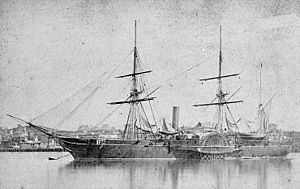USS Saranac (1848) facts for kids

Saranac in port in the 1870s
|
|
Quick facts for kids History |
|
|---|---|
| Name | USS Saranac |
| Namesake | Saranac River |
| Builder | Portsmouth Navy Yard, Kittery, Maine |
| Laid down | 1847 |
| Launched | 14 November 1848 |
| Commissioned | 12 October 1850 |
| Decommissioned | 20 July 1853 |
| Recommissioned | 5 November 1853 |
| Decommissioned | 1 July 1856 |
| Recommissioned | 17 September 1857 |
| Decommissioned | 25 January 1869 |
| Recommissioned | 27 January 1870 |
| Fate | Wrecked 18 June 1875 |
| General characteristics | |
| Tonnage | 1,463 tons |
| Length | 215 ft 6 in (65.7 m) |
| Beam | 37 ft 9 in (11.5 m) |
| Draft | 17 ft 4 in (5.3 m) |
| Depth of hold | 26 ft 6 in (8.1 m) |
| Propulsion |
|
| Speed | 9 knots (17 km/h; 10 mph) |
| Complement | 173 |
| Armament | 11 × 8-inch (200 mm) guns |
The USS Saranac was a special type of warship called a sloop-of-war in the United States Navy. She was built in 1847, during the Mexican–American War. However, by the time she was ready for duty, the war had already ended.
Saranac officially began her service in 1850. She sailed in both the Atlantic Ocean and the Pacific Ocean, helping to protect American interests around the world. When the American Civil War began, Saranac was busy patrolling the West Coast of the United States. Even after the war, she continued to serve the Navy until she was wrecked near Vancouver Island, British Columbia, in 1875.
Contents
Building the Saranac
The Saranac was the second ship to be given this name. Her construction began in 1847 at the Portsmouth Naval Shipyard in Kittery, Maine. She was launched into the water on November 14, 1848.
This new warship was a side-wheel steam sloop. This means she used both sails and a steam engine with large paddles on her sides to move. On April 10, 1850, she went on a test trip in the North Atlantic Ocean. After this trip, she had some repairs and changes made. Finally, she was ready for duty on October 12, 1850, with Captain Josiah Tattnall III in charge.
Early Voyages and Duties
Saranac first operated along the Atlantic coast of the United States as part of the Home Squadron. In June 1852, she was placed "in ordinary" at Philadelphia. This means she was taken out of active service for a while.
She was reactivated in September and sailed to New York City. There, she picked up the Brazilian minister to the United States, Chevalier de Sodre. On October 5, she set sail to take him back home to Brazil. She arrived in Pará on October 26. After dropping off her important passenger, she served on the Brazil Station. She returned to Philadelphia and was taken out of service again on July 20, 1853.
Saranac was put back into service on November 5, 1853. This time, she sailed to the Mediterranean Sea and operated there for nearly three years. She returned to Philadelphia on June 26, 1856. On July 1, she was decommissioned again for repairs to her machinery and to get new boilers.
After being recommissioned on September 17, 1857, she began a very long journey. She sailed south, all the way around Cape Horn at the tip of South America. Then, she sailed back up the Pacific Ocean coast to serve along the west coast of the United States.
Service During the Civil War
Saranac was still performing her duties on the West Coast when the American Civil War began. She continued to protect American trade ships along the coast of California throughout the entire war.
Even after the Confederacy had been defeated, Saranac kept sailing. She was searching for the Southern warship Shenandoah. This ship was still attacking Union (Northern) merchant vessels because its crew didn't know the war had ended yet.
Post-War Missions and Final Voyage
Saranac continued to protect American trade and interests after the Civil War. Her longest period of service ended on January 25, 1869, when she was decommissioned again.
However, she was recommissioned on January 27, 1870. The experienced ship went back to operating along the West Coast of the United States. She served in this area until her final mission.
On June 18, 1875, at 8:40 a.m., Saranac was on a special trip. She was collecting interesting natural items for the Philadelphia Centennial Exposition, a big exhibition. While sailing, she hit a hidden rock called Ripple Rock in Seymour Narrows, near Campbell River, British Columbia.
Her front (bow) immediately crashed into the Vancouver Island shore. The crew quickly tied her to a tree with a strong rope. But within an hour, the ship had completely sunk. Lieutenant Commander Sanders, along with the pilot and thirteen men, walked to Victoria for help. The rest of Saranac's 173 officers and men were brought from Victoria to San Francisco by another ship, the SS Pacific. They arrived on July 1, 1875, at Mare Island.

